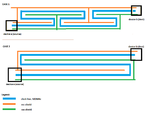meeyaw
Junior Member level 3
Hi edaboard people,
Please help me about this problem shown in the attachment image.

I have two possible routes for a clock line from device A to device B. As you can see, CASE A has more loop than case B. Both cases are shielded by vcc-vss pair.
The question is, which one is more prone to crosstalk: Case A or Case B? May I also know why is that so?
These cases confuses me already about which of them will I implement in layout.
Thanks for anyone who can answer it.
Please help me about this problem shown in the attachment image.

I have two possible routes for a clock line from device A to device B. As you can see, CASE A has more loop than case B. Both cases are shielded by vcc-vss pair.
The question is, which one is more prone to crosstalk: Case A or Case B? May I also know why is that so?
These cases confuses me already about which of them will I implement in layout.
Thanks for anyone who can answer it.